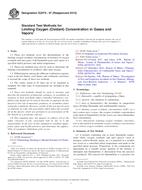Wir benötigen Ihre Einwilligung zur Verwendung der einzelnen Daten, damit Sie unter anderem Informationen zu Ihren Interessen einsehen können. Klicken Sie auf "OK", um Ihre Zustimmung zu erteilen.
ASTM E2079-07(2013)
Standard Test Methods for Limiting Oxygen (Oxidant) Concentration in Gases and Vapors
Automatische name übersetzung:
Standard-Prüfverfahren für Grenz-Sauerstoff (Oxidationsmittel) Konzentration in Gasen und Dämpfen
NORM herausgegeben am 1.10.2013
Informationen über die Norm:
Bezeichnung normen: ASTM E2079-07(2013)
Anmerkung: UNGÜLTIG
Ausgabedatum normen: 1.10.2013
SKU: NS-44218
Zahl der Seiten: 9
Gewicht ca.: 27 g (0.06 Pfund)
Land: Amerikanische technische Norm
Kategorie: Technische Normen ASTM
Kategorie - ähnliche Normen:
Die Annotation des Normtextes ASTM E2079-07(2013) :
Keywords:
ICS Number Code 75.160.30 (Gaseous fuels)
Ergänzende Informationen
| Significance and Use | ||||||||||
|
5.1 Knowledge of the limiting oxygen (oxidant) concentration is needed for safe operation of some chemical processes. This information may be needed in order to start up or operate a reactor while avoiding the creation of flammable gas compositions therein, or to store or ship materials safely. NFPA 69 provides guidance for the practical use of LOC data, including the appropriate safety margin to use. 5.2 Examples of LOC data applications can be found in references (2-4). 5.3 Much of the previous literature
LOC data 1.1 These test methods cover the
determination of the limiting oxygen (oxidant) concentration of
mixtures of oxygen (oxidant) and inert gases with flammable gases
and vapors at a specified initial pressure and initial
temperature.
1.2 These test methods may also be used to determine the limiting concentration of oxidizers other than oxygen. 1.3 Differentiation among the different combustion regimes (such as the hot flames, cool flames and exothermic reactions) is beyond the scope of these test methods. 1.4 The values stated in SI units are to be regarded as standard. No other units of measurement are included in this standard. 1.5 These test methods should be used to measure and describe the properties of materials, products, or assemblies in response to heat and flame under controlled laboratory conditions and should not be used to describe or appraise the fire hazard or fire risk of materials, products, or assemblies under actual fire conditions. However, results of this test may be used as elements of a fire risk assessment which takes into account all of the factors which are pertinent to an assessment of the fire hazard of a particular end use. 1.6 This standard does not purport to address all of the safety concerns, if any, associated with its use. It is the responsibility of the user of this standard to establish appropriate safety and health practices and determine the applicability of regulatory limitations prior to use. |
||||||||||
| 2. Referenced Documents | ||||||||||
|
Ähnliche Normen:
Historisch
1.1.2014
Historisch
15.6.2013
Historisch
1.11.2012
Historisch
1.11.2011
Historisch
1.11.2012
Historisch
1.5.2013
Empfehlungen:
Aktualisierung der Gesetze
Wollen Sie sich sicher sein, dass Sie nur die gültigen technischen Vorschriften verwenden?
Wir bieten Ihnen Lösungen, damit Sie immer nur die gültigen (aktuellen) legislativen Vorschriften verwenden könnten.
Brauchen Sie mehr Informationen? Sehen Sie sich diese Seite an.



 ASTM D2163-14e1
ASTM D2163-14e1 ASTM D2420-13
ASTM D2420-13 ASTM D2598-12
ASTM D2598-12 ASTM D3588-98(2011)..
ASTM D3588-98(2011).. ASTM D3956-12
ASTM D3956-12 ASTM D3984-13
ASTM D3984-13
 Cookies
Cookies
